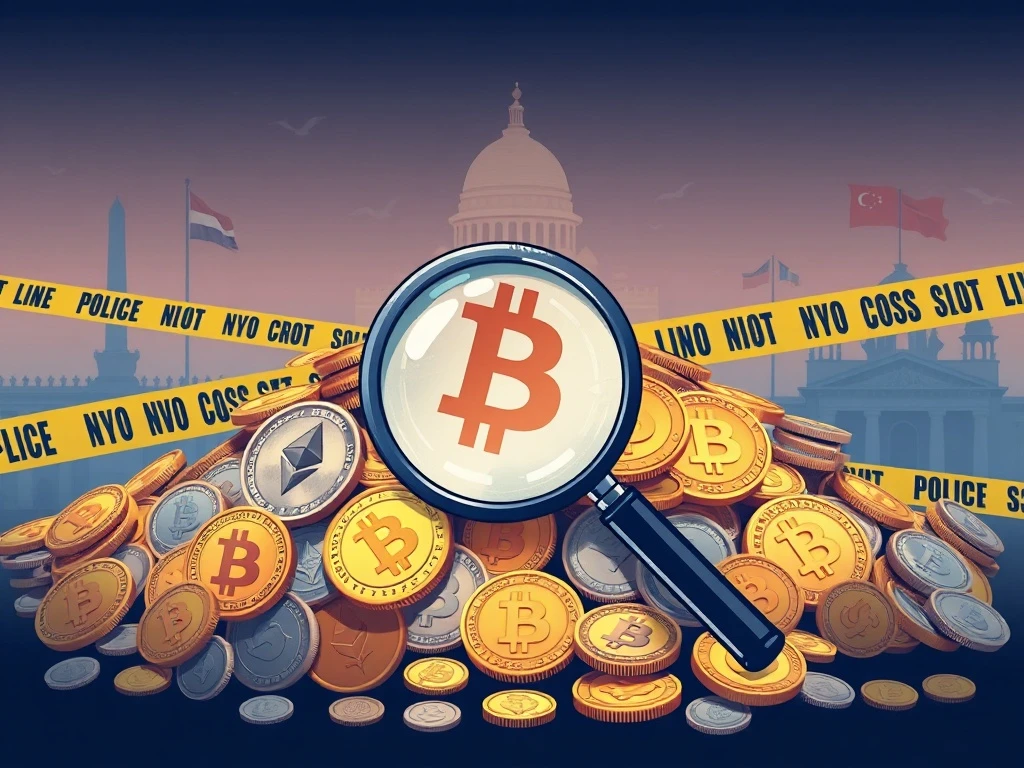Shocking Figures: Chainalysis Reveals $75B in Seizable Crypto as US Bitcoin Reserve Stalls

The cryptocurrency world faces a critical juncture. Recent revelations from Chainalysis indicate a staggering $75 billion in potentially seizable crypto assets tied to illicit activities. This figure dramatically impacts ongoing discussions about national crypto reserves, particularly as the US Bitcoin Reserve initiative encounters hurdles. Governments worldwide are now evaluating new strategies for managing digital assets, potentially leveraging these findings for future financial stability.
Unpacking the Chainalysis Report: A Deeper Look at Illicit Crypto Activity
A new Chainalysis report, published recently, offers crucial insights into the vast sums of cryptocurrency connected to illegal operations. The blockchain analytics firm estimates that over $75 billion in crypto balances are linked to various illicit activities. This includes significant amounts held directly by criminal entities. Furthermore, it encompasses funds in wallets with downstream exposure to these nefarious sources. These findings highlight the pervasive nature of illicit crypto activity across the digital landscape.
Specifically, the report breaks down these figures:
- **$15 billion:** Held directly by illicit entities.
- **$60 billion:** Located in wallets with downstream exposure to these entities.
Darknet market operators and vendors control a substantial portion, holding more than $40 billion in crypto assets on the blockchain. While Bitcoin (BTC) accounts for approximately 75% of this total illicit value, stablecoins are increasingly used in such activities. Stolen assets, unfortunately, represent the largest share of these illicit cryptocurrency holdings, underscoring the ongoing challenges in digital asset security.
Strategic Implications for National Crypto Reserves and Asset Forfeiture
The implications of these findings extend far beyond law enforcement. Nations globally are actively considering the establishment of national crypto reserves. The United States, for example, under the previous Trump administration, initiated efforts to create a Strategic Bitcoin Reserve and Digital Asset Stockpile. These programs aimed to expand federal crypto holdings without impacting the budget. Consequently, asset forfeitures emerge as a key, budget-neutral mechanism for acquiring these reserves.
Chainalysis co-founder and CEO Jonathan Levin emphasized the transformative potential of these figures. He noted that the data elevates “asset forfeiture potential to a completely different level.” This insight fundamentally alters how countries might approach their digital asset strategies. The cryptocurrency ecosystem, therefore, presents law enforcement with an unprecedented opportunity: billions of dollars in illicit proceeds are sitting on public blockchains, theoretically seizable if authorities can effectively coordinate action.
The Stalled US Bitcoin Reserve and Global Seizure Efforts
While the prospect of building a US Bitcoin Reserve through forfeiture seems promising, the initiative’s progress has been slow. This stagnation occurs precisely when the potential for asset recovery is at its peak. Meanwhile, other nations are moving forward with significant seizures. Canadian authorities recently confiscated approximately $40 million in digital assets from TradeOgre, a cryptocurrency exchange accused of operating without proper registration and facilitating money laundering. This action, however, sparked considerable criticism from the crypto community, who argued it overstepped regulatory boundaries.
These events highlight the complex interplay between law enforcement, regulatory frameworks, and public perception in the rapidly evolving crypto space. Recovering these funds could bolster national treasuries and contribute to broader economic stability. Yet, the legal and ethical challenges remain substantial.
Transparency vs. Perception: Understanding Crypto Crime Statistics
Despite the significant dollar amounts associated with illicit crypto activity, it is crucial to maintain perspective. While crypto crime has seen increases in recent years, including several high-profile hacks, its overall scale remains relatively small. According to Chainalysis’s 2025 Crypto Crime Report, illicit transactions accounted for just 0.14% of all blockchain activity in 2024. This figure continues a downward trend observed in previous years, indicating improving security and tracking measures.
By contrast, traditional financial systems face a much larger challenge. The United Nations Office on Drugs and Crime (UNODC) estimates that 2%-5% of global GDP is laundered through conventional banking. This stark comparison reveals a critical aspect of crypto crime: blockchain transparency often skews public perception. Every transaction on a public blockchain is traceable, making illicit activity easier to detect and, consequently, more frequently reported than crimes involving cash or traditional banking systems. As a relatively new technology, the crypto ecosystem also faces intense regulatory and enforcement scrutiny, which further amplifies perceptions of widespread wrongdoing. Therefore, understanding the true scale requires careful analysis of crypto crime statistics against broader financial crime data.
The Future of Seizable Crypto Assets and Law Enforcement
The extensive data provided by the Chainalysis report underscores a pivotal moment for global law enforcement and governments. The ability to identify and potentially seize billions in seizable crypto assets offers a powerful new tool in the fight against financial crime. This capability also presents a unique opportunity for nations to bolster their digital reserves through asset forfeiture. The ongoing development of sophisticated blockchain analytics tools continues to enhance the visibility of illicit flows, making the digital realm less anonymous than many criminals might assume.
As discussions around national crypto reserves evolve, these insights will undoubtedly play a central role. The challenge lies in developing robust legal frameworks and international cooperation mechanisms to effectively recover these funds. The journey toward a more secure and transparent crypto ecosystem is continuous, marked by technological advancements and persistent regulatory efforts. This evolving landscape promises both significant challenges and unparalleled opportunities for financial security and governmental asset management.









